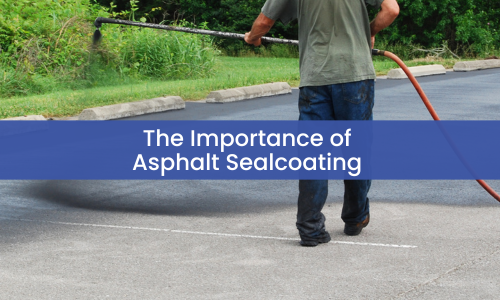One of asphalt’s many benefits is its durability. If properly maintained, asphalt paving can last for decades, whether it’s used on a driveway, a parking lot, a road – asphalt has a long life.
To optimize asphalt’s lifespan, though, it needs occasional sealcoating. Pavement experts recommend applying sealcoat when the asphalt is first installed and then every other year after that. By sticking to this schedule, property owners will maximize the return on their pavement investment.
Regular Asphalt Maintenance Saves Money in the Long Run
There’s always a temptation to put off maintenance, but the longer it’s put off, the more likely expensive repairs – or replacement – will be required.
As durable as asphalt is, it only retains that long-term durability if it’s properly maintained. Exposure to weather, the elements and traffic will stress the pavement and leave it vulnerable to severe damage. Regular maintenance stops this destructive cycle from getting out of control and causing early failure.
Also, maintenance is less expensive than a repair job, and much less expensive than replacement. This is a truism that engineers are taught early on in their careers – it always takes less energy to maintain something rather than repair it. In other words, every dollar spent on sealcoating now will save many dollars on repairs or replacement down the line.
Four Reasons to Invest in the Occasional Sealcoat Application
Sealcoating is a primary form of asphalt pavement maintenance and the least expensive. Chemically, sealcoat is an emulsion – a mix of asphalt oils, water, and an emulsifier that allows the two to thoroughly mix.
It’s a simple formula, but if applied every other year, asphalt sealcoat provides several benefits to the pavement. Read on to learn more about the benefits of investing in occasional sealcoat application.
Sealcoating Protects the Asphalt Pavement from Cracks and Aggregate Loss
Asphalt sealcoat is sprayed onto the pavement or poured and then spread using a squeegee. In this form, it’s a thin fluid that’s easy to push into the asphalt pavement surface. This ensures the emulsion penetrates as deeply into the pavement as possible. When it dries, the emulsion forms into a thick, sticky substance that essentially “glues” the surface level aggregates together.
Aggregate loss is a noted issue for asphalt. As it wears, ages, and deteriorates, asphalt sheds aggregate and develops cracks. It’s important to deal with these early signs of damage because they almost always lead to worse, and more expensive issues.
On-schedule sealcoating slows this process by imparting additional flexibility into the pavement’s surface. This boosts the pavement’s loadbearing capabilities and resistance to impact damage. Seal coated pavement is also less likely to develop cracks due to better adhesion between aggregates.
Sealcoating Defends Against UV Rays and Weather Damage
Rain, sun, snow, ice, or extreme heat – your pavement must endure it all. Extreme temperatures will cause the pavement to swell and contract. UV rays and water both cause chemical damage that can undermine the asphalt’s integrity.
Defending against these sources of damage is important, and sealcoating is designed to do that. Once applied, the sealcoat acts like a protective layer, shielding against UV radiation and minimizing the effect of water on the pavement. Sealcoat also defends against oxidation, which eventually stiffens the pavement to the point where it becomes brittle.
Sealcoating Helps Prevent Water and Dirt Intrusion
Once the sealcoat cures, it fills the spaces inside the pavement, making it difficult for dirt and water to penetrate into the pavement. Both can do serious damage to asphalt from the inside out, eventually leading to potholes and pavement-ruining base failures. Water is asphalt’s nemesis and will quickly erode the pavement if it’s allowed to collect on the asphalt and seep in through cracks.
Sealcoat provides a moisture barrier and applying it regularly will ensure that barrier is always up and active.
Sealcoating Improves the Pavement’s Appearance and Curb Appeal
Sealcoat is primarily made up of asphalt components, so it blends in perfectly with existing pavement. In fact, it restores the asphalt’s appearance, giving it that just mixed and installed look. As the material ages, it has a tendency to fade in color. Gray asphalt is a sure sign of age-based wear, and it can take the property’s curb appeal with it. For commercial property owners, a smooth, black patch of asphalt is a sign of regular maintenance and a sign that the company cares about its appearance and professionalism. A good time to stripe the asphalt is right after sealcoating, to maximize visibility for motorists.
Asphalt Surfaces Take a Beating, But Sealcoating Offers It Protection
As soon as asphalt is installed, it’s under attack by UV radiation, moisture, temperature swings, traffic, oxygen, chemical spills, and plenty of other stressors. Without protection in place, the pavement will quickly fail and take your investment with it.
Sealcoating is that critical layer of protection, and when applied by a trusted Houston pavement contractor, it can provide ongoing defense against for your pavement.
- HOA & Condos – How Asphalt Pavement Can Affect Your Houston Property Values - March 6, 2025
- What Certifications or Licenses Should a Houston Asphalt Contractor Have? - September 17, 2024
- Common Challenges in Concrete Construction - September 11, 2024

